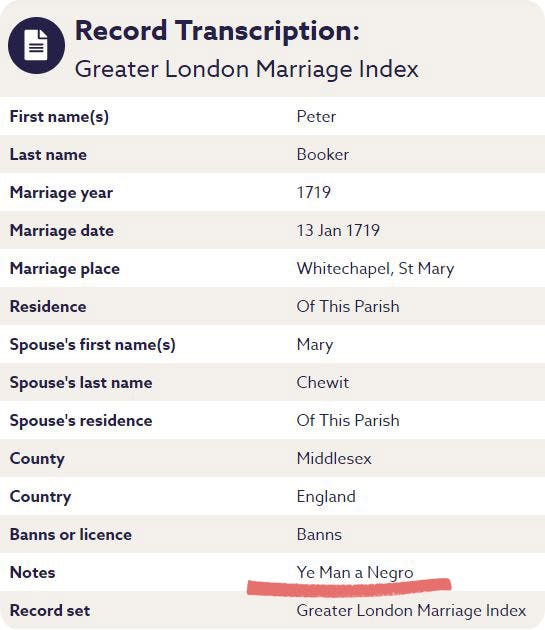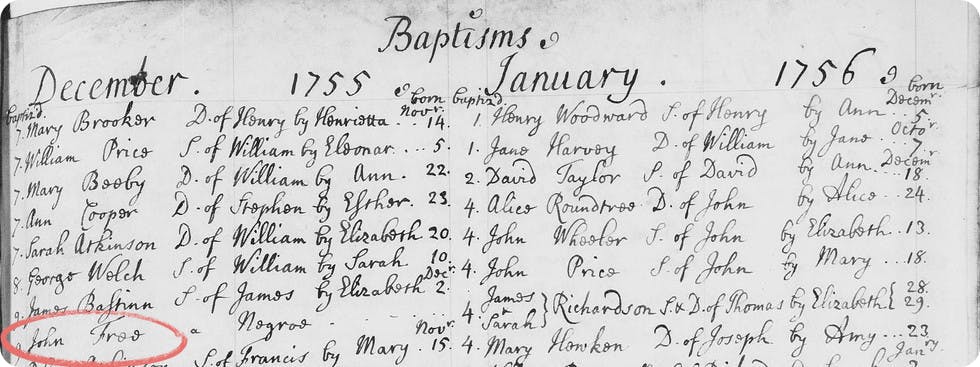A very brief history of Africans in British family records
4-5 minute read
By Alex Cox | September 21, 2020

Take an insightful trip through history with some tips on identifying Black people in historical documents.
People of African and Asian origin have been living in Britain throughout history. Many of these individuals arrived hundreds of years before the massive migrations sparked by the slave trade and European colonisation during the 17th, 18th and 19th centuries.
In fact, Britain's earliest African immigrants arrived in Roman times when black legionaries were sent to the Roman province of Britannia. A number of them decided to stay when the legions left in the 5th century AD.
Medieval times
During the 9th century, Viking fleets brought captured peoples from the coasts North Africa and Al-Andalus to Britain and Ireland and, during the Middle Ages, significant numbers of North African Moors arrived via Islamic Iberia in Spain. Queen Elizabeth is reported to have complained about the number of 'blackamoores' in London as early as 1556.

1560 burial of a 'John Blackamoore' in Cranbrook, Kent. View the full record.
By the time the SS Windrush arrived in 1948, carrying the first post-war arrivals from the Caribbean, Britain was already home to established Black and Asian populations. Whether working as servants in country houses, enlisting in the armed forces, marrying in parish churches, producing art, or attempting social reform, evidence of these early immigrants can be found in many areas of British life.
Finding evidence in family records can be tricky as Black and Asian people were not always identified by their race. For example, British Army Service Records may occasionally indicate whether a soldier was of African or Asian origin through descriptions of their complexion ('Black', 'Copper', 'Negro' or 'Moor') although usually, no indication was given. The fact that the first national census was not taken until 1801 also means that there is no way of being certain of how many Black and Asian people were living in Britain.

Private James Goodwin was born in Barbados and joined the British army in 1809. He served in the Battle of Waterloo and his service records describe him as having 'woolly hair, black eyes, and a black complexion'. View the full record.
18th-century slave trade
While there had been an African presence in Britain since the Roman Times, the most significant cause of African migrations was certainly the slave trade. By the 18th century, Britain was an active leader in the Atlantic slave trade and was transporting thousands every year to maintain the highly profitable plantations that were dotted around the West Indian colonies. Although most British-owned slaves were located overseas, a significant number were brought back to Britain.

A number of early African immigrants can be found in parish records like this 1719 marriage. The groom's ethnicity is mentioned in the notes.
By the mid-18th century, London had the largest Black population in the country, made up of free and enslaved people, as well as many runaways.

Members of the wealthy upper classes regarded Black servants as highly fashionable. They were seen as markers of wealth, status, and refinement and would regularly be included in family portraits. There were also notable Black populations in Liverpool, Bristol, Bath, and Lancaster and smaller numbers were also found in rural areas throughout the country.

The First Earl Spencer hunting with his son and a Black servant.
The relationships between Black people and their masters or employers in Britain appear to have been more complex than those of the planters and their slaves in the colonies. Some employers left money to their Black workers in wills. One master elevated his servant, Mingo, to the position of lighthouse keeper in his will. However, these cases were exceptional. Generally, life was hard and opportunities were limited for all members of the working classes during this period.
In the late 18th century, the status of Black servants in Britain radically changed. After 1772, slavery in Britain became rare and was likely to attract legal action or lead to ostracism. This change in attitude was brought about by the Somerset case of 1772.
What was the Somerset case?
Somerset, a fugitive enslaved African brought a case against his owner who was attempting to force him to return to the West Indies. Lord Justice Mansfield ruled that it would be illegal to remove Somerset from the country against his wishes and the case partially extended the rights of enslaved Africans in Britain and formed the beginning of a much wider campaign against slavery. This landmark victory was celebrated by a ball held at a Westminster pub, which allegedly attracted nearly 200 Black revelers. That same year, Lord Mansfield put the number of Africans in the country as a whole at 15,000.

Advertisements from our collection of historical British newspapers show how slaves were traded in Britain. Bath Chronicle and Weekly Gazette September 28, 1769. Read the full article.
Not all Africans who arrived in the country during this period were enslaved. Many free Africans were recruited as sailors on merchant vessels or joined the Royal Navy. A number of these sailors will have settled and raised families in and around Britain's ports. Some African merchants also conducted business with British traders.
The landmark ruling in the Somerset case also encouraged larger numbers of enslaved Africans to seek refuge in Britain. This increase in numbers is evident in parish records, particularly in baptisms. In many cases, baptisms occurred in adulthood once the enslaved Africans had reached Britain. It was widely believed that a Christian baptism guaranteed full freedom and although this was not the case, Christianity certainly provided them with a new kind of acceptance in British society. From the late 18th century, parish records contain numerous references to 'black', 'negro' and 'blackamoor'.

In 1755, former slave John Free was baptized in the parish of St Margaret, Westminster. His parents are listed as 'Negroe'. View the full record.
After conversion, many Africans were given English Christian names, with Biblical names such as John Baptist proving popular. The celebrated abolitionist and former slave, Olaudah Equiano, was baptized Gustavus Vassa at St Margaret's, Westminster after fleeing to Britain from America.

It's often impossible to tell whether the Black people mentioned in records were free or enslaved. It should not be assumed that a person described as a 'Negro' in the 16th, 17th, or 18th centuries was a slave. Many Black people were never enslaved. And those that were, may have been granted or bought their freedom or claimed it when they entered the military.
Do you have an incredible story about a Black ancestor that you'd like to share? Use #FindmypastFeatured on your social media posts. We love hearing about your family discoveries.
Related articles recommended for you

Discover Country Life and so much more
What's New?

Taylor Swift’s family tree shines with love, heartbreak and the triumph of the human spirit
Discoveries

The Women's Prize Trust announces Findmypast as the inaugural sponsor of the Women's Prize for Non-Fiction
The Findmypast Community

